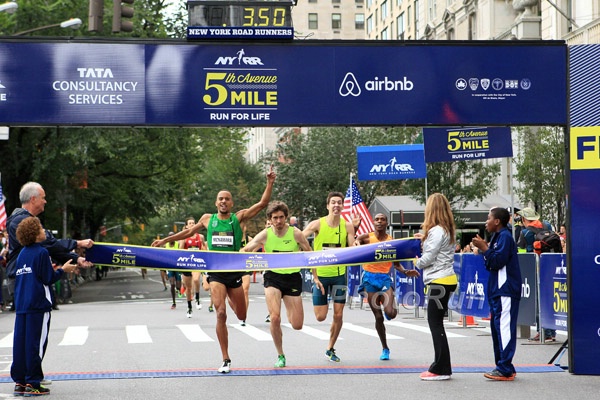Choosing the mile over the marathon


In a recent article that appeared in the Wall Street Journal, writer Kevin Helliker observed that although the mile had waned in popularity in the 1990s, it’s made a huge comeback in recent years. When the race started back in 1981, New York’s Fifth Avenue Mile hosted just 52 runners, mostly elites and a few very fast club runners. The event now boasts 5,000 entrants of all ability levels.
Helliker cites a litany of reasons why the mile has charged back on the scene in New York. The two major reasons are that running shorter distances can actually be healthier than laying down repeated high mileage weeks and that shorter distances are much more accessible for newer runners. Helliker hits on a point that mainstream marathon culture is loathe to acknowledge: a good time in a mile event carries a whole lot more weight than accounts of a five-hour marathon ordeal of survival.
Shorter distance intervals have always been an essential, though agonizing, part of marathon training. Legendary Toronto Olympic Club coach Paul Poce once remarked that the marathon is a 32K preamble to a 10K race and that the only way to triumph in the last quarter was to work on 400 and 800m repeats; distances that are anathema to the slow twitch demographic. Marathoners are justified in their fear of the track. If the marathon is a slow death, then the 5K is swift and acute agony. And, if a runner doesn’t feel like they are dying (or at least wishing for death) in 1,000m repeats, they’re not doing it right.
Running is a paradox. It’s a solitary sport practised often in large groups. It causes otherwise well-adjusted people to self-inflict debilitating injuries in pursuit of better health. But it also awards medals to everyone, provides more entertainment en route than a parade and maintains unbridled enthusiasm for every other tertiary aspect that doesn’t concern speed. The marathon is about the only athletic endeavour that actively denies that it’s a sport at all. There is nothing wrong with saying that running is a sport. We should all embrace that we are athletes. Being competitive is fun; with the right attitude, it brings out the best in all of us.
Malcolm Gladwell broke 5:00 at fifth ave mile today, with 4:54 pic.twitter.com/G3ThYkj4Yz
— wade lambert (@wadeNYC) September 13, 2014
Helliker makes a valid but concerning point that higher quality participation is inherent in shorter distance racing, making races like a road mile potentially intimidating for recreational runners. But the Fifth Avenue Mile is an example of the distance done right. Runners of all abilities get to go head-to-head in seeded groups, creating a fun, competitive environment meant to inspire those that have never experienced the thrill of a 1,609m dash.
If the first running boom was about speed, the current one is about completion. Running 42, 50 or 100K is always a huge accomplishment in itself, but when the vast majority of the population, given enough time, can accomplish this feat, very few us are breathing rarefied air.
Consequently, when distance is taken out of the equation and when the challenge shifts from lumbering over a long distance to flying through a course measured not in kilometres and hours but in metres and seconds, focus invariably shifts to the value of the performance.
It’s a value that, sadly, our road racing culture gave up on a long time ago.
The marathon and the mile are categorically different events. There’s no emotional abyss after 35K, there’s no glycogen depletion and no wall to hit. But there is a sense that shorter distance events, including the mile, emphasize the ideals that once animated the marathon: pushing yourself to your absolute limit and taking a risk in order to prove what you’re really capable of.
The next time you see a mile race in your area, give it a shot. Who knows? You might just discover that you’re faster than you think.


